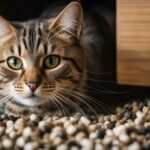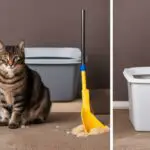Cats are creatures of habit who thrive on routine. Most cats will have a set pattern they follow every day. Cats are territorial animals, so their routines will develop around your schedule and your household routines. While such a routine-driven life may seem boring to humans, it helps cats feel safe and confident. In fact, routines are so important to cats that having them disrupted can even impact their physical health. Changes in routine can make cats sick, as shown in a study conducted at the Ohio State University. It found that when cats’ environments and daily routines were changed, even healthy cats got sick. Keeping a consistent routine is key to keeping cats happy and healthy.
Key Takeaways
- Cats are creatures of habit who thrive on routine.
- Routine provides cats with a sense of predictability, consistency, and comfort.
- Changes in routine can impact cats’ physical health and make them sick.
- Establishing a consistent routine helps cats feel safe and confident.
- Keeping a routine is essential for maintaining cats’ happiness and overall well-being.
The Importance of Routine for Cats’ Well-being
Routine is essential for the well-being of cats, as it provides them with a structured and familiar environment. Cats thrive on orderliness, organization, and predictability, and having a consistent routine helps them feel more secure and comfortable. By following a routine, cats can anticipate and expect certain activities, which creates a sense of stability in their lives. This structured routine allows them to navigate their day with ease and helps reduce stress and anxiety.
A cat’s routine plays a significant role in their overall mental and emotional health. By knowing what to expect, cats feel more in control of their surroundings and are less likely to experience fear or anxiety. Additionally, having a consistent routine helps cats establish a sense of independence and autonomy. They can rely on their routine to provide them with essential activities such as feeding, playtime, and rest, which contributes to their overall well-being.
Creating and maintaining a routine for your cat involves various aspects of their daily life. This includes establishing a consistent feeding schedule, providing regular playtime and exercise, maintaining a grooming routine, and ensuring a clean and comfortable litter box. By incorporating these activities into a structured routine, you are promoting your cat’s physical and mental health, as well as their overall happiness and contentment.
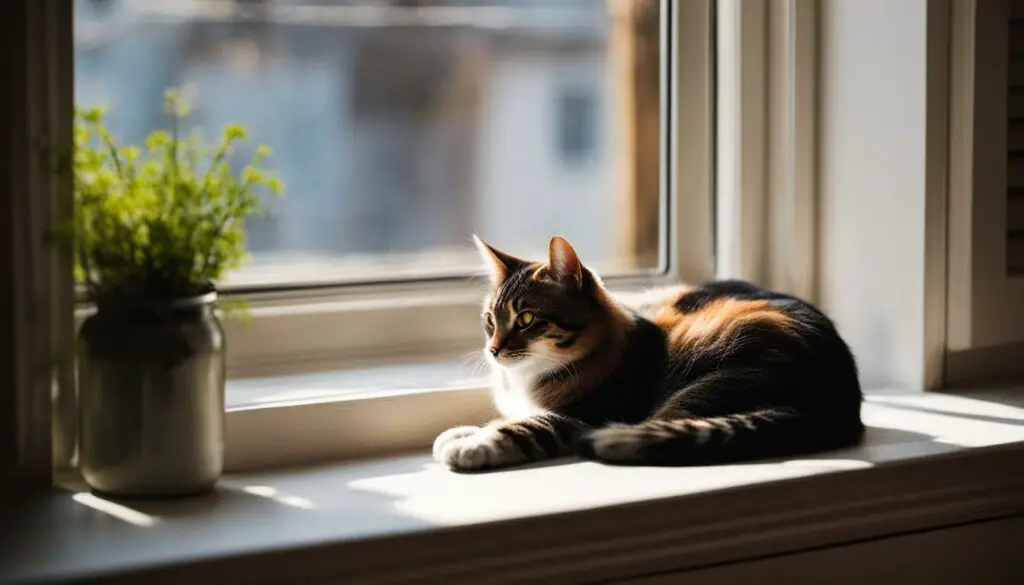
The Benefits of a Structured Routine
A structured routine not only benefits cats but also provides advantages for their owners. By having a clear routine, you can better manage your time and schedule, ensuring that you can provide your cat with the care and attention they need. A routine also helps establish a bond and trust between you and your cat, as they learn to rely on you for their daily activities.
| Benefits of a Structured Routine for Cats | Benefits of a Structured Routine for Owners |
|---|---|
|
|
The Role of Routine in Cats’ Territory Marking
When it comes to territory marking, routine plays a crucial role in a cat’s behavior. Cats are territorial animals, and marking their territory is a natural instinct. By following a routine, cats can become familiar with their environment and establish their scent, which helps them define their territorial boundaries.
Cats use scent to communicate with other cats, signaling that an area is already claimed. By having a routine, cats can consistently mark their territory and maintain a sense of security and control over their surroundings. This routine-driven behavior not only helps cats establish their territory but also allows them to feel more confident and comfortable in their home.
To better understand the role of routine in territory marking, let’s take a look at the following table:
| Routine | Effect on Territory Marking |
|---|---|
| Consistent marking in specific areas | Establishes clear territorial boundaries |
| Regular scent marking on furniture and objects | Communicates ownership and warns other cats |
| Following a predictable routine | Provides cats with a sense of security and control |
As shown in the table, having a routine that includes consistent marking and following a predictable pattern can help cats establish and maintain their territory, creating a stable and secure environment for them.
The Impact of Routine on Independence and Security
When it comes to cats, routine plays a vital role in fostering their sense of independence, autonomy, and self-sufficiency. By having a predictable routine, cats are able to navigate their day independently, knowing when to expect certain activities. This sense of autonomy provides them with a feeling of security and safety, allowing them to explore and engage with their environment without fear or anxiety.
Cats are naturally cautious creatures, and routine helps them feel more confident and self-reliant. By having a consistent schedule, cats can anticipate what will happen next, reducing their stress levels and promoting a sense of stability. This structured environment allows them to adapt more easily to changes or variations in their surroundings, enhancing their overall well-being and sense of security.
Having a routine in place for my cat has made a significant difference in her behavior and overall happiness,” says cat owner Jane. “She knows exactly when playtime, feeding, and cuddling will happen, and she has become much more confident and content as a result.”
| Benefits of Routine for Cats’ Independence and Security |
|---|
| Promotes independence and autonomy |
| Reduces stress and anxiety |
| Enhances confidence and self-reliance |
| Creates a sense of security and safety |
By incorporating routine into their daily lives, cat owners can have a positive impact on their cats’ independence and security. Providing a structured and predictable environment helps cats feel more comfortable and confident, allowing them to thrive both mentally and physically.
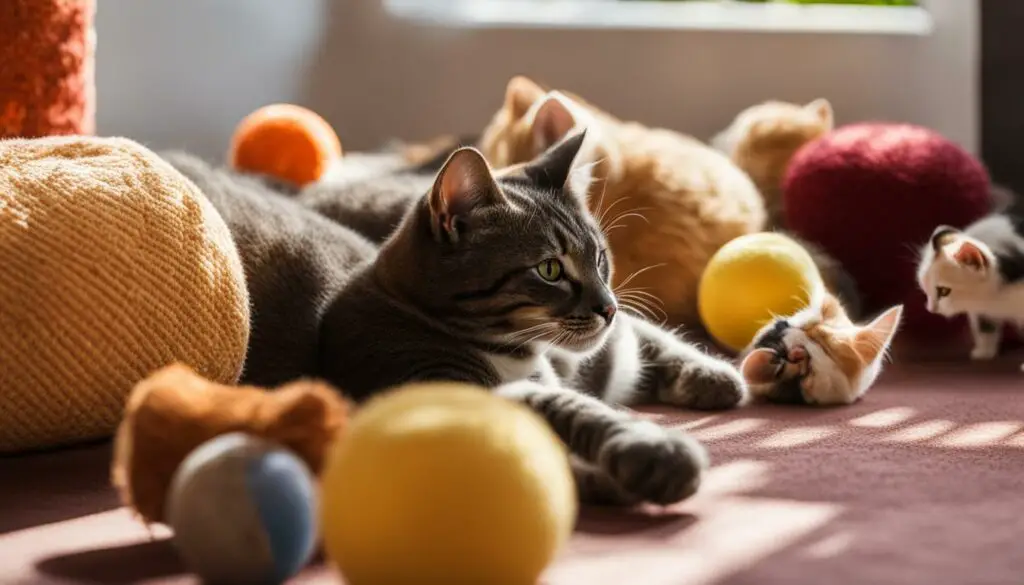
The Role of Routine in Minimizing Stress and Anxiety
Stress and anxiety can have a significant impact on a cat’s overall well-being. Just like humans, cats can experience stress and anxiety in various situations. However, routine plays a crucial role in minimizing these negative emotions and promoting a sense of relaxation and calm.
When a cat has a predictable routine, they can anticipate what will happen next, creating a sense of familiarity and security. This predictability helps to reduce stress levels and promotes a feeling of comfort and stability. Cats thrive in a structured environment, and routine provides the necessary structure for them to feel at ease.
“Routine provides a sense of stability and normalcy, which can help cats feel safe and secure. By sticking to a consistent routine, you can minimize the chances of triggering stress or anxiety in your feline companion.”
– Dr. Emily Johnson, Feline Behavior Specialist
In addition to reducing stress, routine also allows cats to develop coping mechanisms and adapt more effectively to changes in their surroundings. By providing a stable routine, you create a solid foundation that helps cats navigate through new experiences with less anxiety and fear.
The Benefits of Routine in Minimizing Stress and Anxiety:
- Reduces anxiety levels by providing a sense of predictability and familiarity
- Promotes relaxation and a feeling of calm
- Helps cats develop coping mechanisms and adapt to new situations
- Creates a structured and secure environment
- Minimizes the chances of triggering stress-related health issues
By incorporating a consistent routine into your cat’s daily life, you can help minimize their stress and anxiety levels, promoting a happier and healthier feline companion. Remember, each cat is unique, so it’s important to establish a routine that suits your cat’s individual needs and preferences.
| Causes of Stress and Anxiety in Cats | Signs of Stress and Anxiety in Cats |
|---|---|
| Loud noises | Excessive grooming |
| Changes in the environment | Loss of appetite |
| Introduction of new pets | Aggression towards humans or other animals |
| Changes in routine | Isolation or hiding |
Remember to consult with a veterinarian or a feline behavior specialist if you notice persistent signs of stress or anxiety in your cat. They can provide valuable guidance and help you create a routine that best meets your cat’s needs.
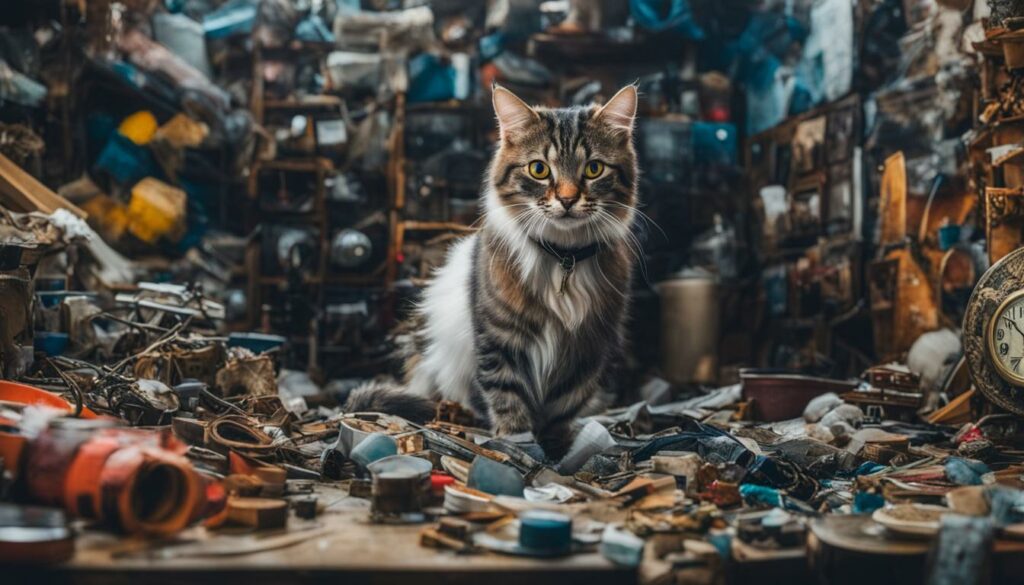
Routine and Daily Care Activities
When it comes to taking care of our feline friends, establishing a routine is key to ensuring their well-being. From playtime to feeding schedules, grooming routines to litter box maintenance, incorporating a consistent routine into your cat’s daily life promotes their overall health and happiness.
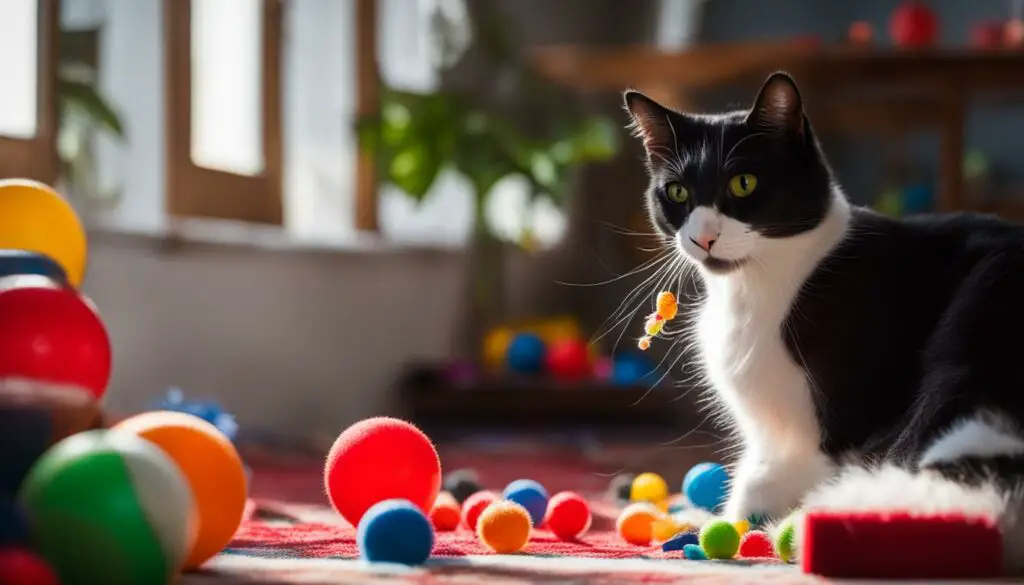
Playtime
Playtime is not only a fun and bonding activity for you and your cat but also essential for their mental stimulation and physical exercise. By setting a regular playtime routine, you provide your cat with a structured outlet for their natural hunting instincts and energy release. Whether it’s chasing a toy mouse, batting at a feather wand, or engaging in interactive play, playtime helps keep your cat entertained, prevents boredom, and promotes a healthy lifestyle.
Feeding Schedule
A consistent feeding schedule is vital for your cat’s nutrition and digestive health. Cats are creatures of habit, and establishing a routine for their meals helps regulate portion control and prevents overeating. By feeding your cat at the same times each day, you provide them with a sense of predictability and stability. Additionally, a regular feeding schedule can help prevent obesity-related health issues and create a positive association between your cat and mealtime.
Grooming Routine
Maintaining a regular grooming routine is essential for your cat’s hygiene and overall well-being. Brushing their fur helps remove loose hair, prevents matting, and promotes a healthy coat. Trim your cat’s nails regularly to prevent overgrowth and discomfort. By incorporating a grooming routine into your cat’s schedule, you not only keep them looking their best but also create a calm and positive experience for both of you.
Litter Box Routine
Establishing a routine for your cat’s litter box is crucial for their bathroom habits and overall cleanliness. Cats prefer a clean and well-maintained litter box, so regular scooping and cleaning are necessary. By following a consistent litter box routine, you ensure that your cat always has a comfortable and appropriate place to eliminate. This routine also helps prevent issues with inappropriate elimination and promotes good litter box habits.
| Activity | Frequency |
|---|---|
| Playtime | Daily |
| Feeding | 2-3 times a day |
| Grooming | As needed, but at least once a week |
| Litter Box Cleaning | Once or twice daily |
Routine and Behavioral Patterns
Routine plays a significant role in shaping and maintaining cats’ behavioral patterns. Cats are creatures of habit, and having a consistent routine helps reinforce desired behaviors and prevent unwanted changes in their behavior. Whether it’s training, obedience, or socialization, incorporating these activities into a cat’s regular routine can enhance their learning and development.
Training a cat requires consistency and repetition. By establishing a training routine, you provide clear expectations and reinforce desired behaviors. Positive reinforcement during training sessions, such as using treats or praise, helps cats associate the desired behavior with a positive outcome.
“Consistency is key when training cats. By incorporating training sessions into your cat’s routine, you create a structured approach that promotes their learning and obedience. Remember to keep training sessions short, engaging, and enjoyable for both you and your cat.”
Socialization is another aspect of a cat’s behavior that can benefit from routine. Regular positive interactions with humans and other animals help cats become comfortable and confident in different social settings. By incorporating socialization activities into their routine, such as playdates or supervised introductions, cats can learn to interact with others in a positive manner.
Benefits of Routine for Behavioral Patterns
Routine provides cats with a sense of order and familiarity, reducing stress and anxiety. By incorporating training and socialization into their regular routine, you create a structured environment that promotes their well-being and helps them adapt to new situations with ease.
The Benefits of a Structured Environment
A structured environment offers numerous advantages for cats, promoting their overall well-being and adaptability. By providing a consistent and organized routine, cats experience a greater sense of stability and security in their surroundings.
Having a structured environment helps cats feel more comfortable and at ease. They thrive when they can predict and anticipate what will happen next, creating a sense of familiarity and reducing stress and anxiety. This predictability allows cats to navigate their environment with confidence, promoting a greater sense of independence and self-assurance.
Additionally, a structured environment enhances a cat’s adaptability. By establishing a regular routine, cats become more flexible in handling changes and variations in their surroundings. They are better equipped to handle new experiences and transitions while maintaining a sense of stability and security.
Creating a structured environment for your cat not only benefits their mental and emotional well-being but also provides them with the comfort and stability they need to thrive.
Promoting a Structured Environment for Your Cat
Here are some practical ways to promote a structured environment for your cat:
- Establish a daily routine: Set consistent times for feeding, playtime, and rest to create a predictable schedule for your cat.
- Provide a designated space: Set up specific areas for essential activities like eating, sleeping, and using the litter box to maintain orderliness and help your cat anticipate what to expect in each area.
- Create a secure environment: Ensure your cat’s surroundings are safe and free from potential hazards. Eliminate any potential stress triggers and create a peaceful atmosphere.
- Provide mental stimulation: Incorporate interactive toys and activities into your cat’s routine to keep them mentally engaged and prevent boredom.
By following these guidelines and establishing a structured environment, you can create an optimal living space for your cat, promoting their well-being and happiness.

Cats’ Preference for Familiar Surroundings
When it comes to their home, cats have a strong preference for familiar surroundings. They feel most comfortable and secure in their own space, which is often referred to as their “comfort zone.” Cats thrive on sameness and routine, as it provides them with a sense of stability and predictability.
Just like humans, cats find comfort in the familiar. They prefer to have their own designated spots, such as a cozy bed or a favorite perch, where they can retreat to whenever they need some downtime. Creating a consistent routine within their environment, such as keeping their food and water bowls in the same place or providing a predictable playtime schedule, helps cats feel at ease and in control of their surroundings.
“Cats are creatures of habit. They like their routine and they like to stick to it,” says Dr. Emily Stein, a veterinarian specializing in feline behavior. “Having a consistent routine in their home helps them feel safe and secure.”
While some variation can be stimulating for cats, too much change can lead to stress and anxiety. Cats may exhibit signs of distress, such as hiding, excessive grooming, or even urinating outside of the litter box when their familiar surroundings are disrupted. It is important to strike a balance between providing a stimulating environment and maintaining the familiar routine that cats crave.
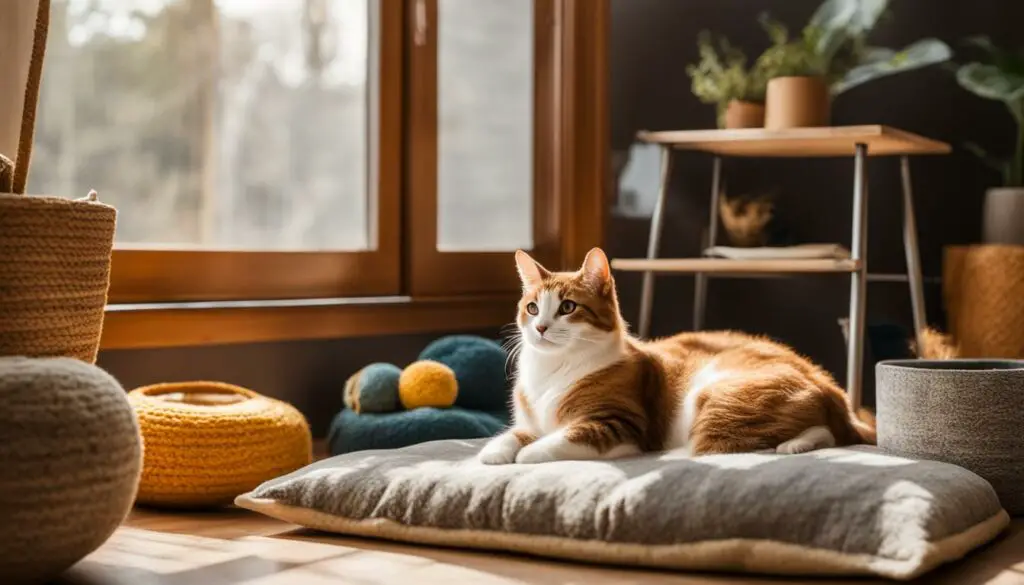
| Benefits of Familiar Surroundings for Cats | Challenges of Too Much Variation |
|---|---|
|
|
The Importance of Routine in Creating a Familiar Environment
Establishing a routine is key to creating a familiar environment for your cat. By keeping their daily activities consistent, such as feeding times, play sessions, and grooming routines, you provide them with a predictable structure that they can rely on. This routine helps them navigate their world with confidence and reduces their stress levels.
Additionally, introducing new experiences gradually and in a controlled manner can help cats adapt to their surroundings without overwhelming them. Whether it’s introducing a new piece of furniture or bringing home a new family member, allowing your cat to familiarize themselves at their own pace ensures a smoother transition and helps maintain their sense of familiarity.
Remember, a happy and content cat is one that feels safe and secure in their own environment. By understanding and respecting their preference for familiar surroundings, you can create a home that nurtures their well-being and enriches their lives.
Section 10: Understanding Cats’ Sleep Patterns
Cats have unique sleep patterns that are influenced by their natural instincts and routine. Understanding these sleep patterns is crucial for providing your cat with the restorative sleep they need. Cats typically sleep for 12-16 hours a day, with intermittent periods of wakefulness. This sleep routine allows them to conserve energy while still remaining alert for hunting and other activities.
During sleep, cats go through different stages, including REM (Rapid Eye Movement) sleep and deep sleep. REM sleep is characterized by rapid eye movements, increased brain activity, and dreaming. It is during this stage that cats may twitch their paws or whiskers, indicating that they are engaged in active dreaming. Deep sleep, on the other hand, is a state of relaxation and physical restoration, where cats experience slower brain activity and lowered levels of responsiveness.
Sleep routine plays a vital role in promoting cats’ overall health and well-being. By establishing a consistent sleep routine, you can ensure that your cat gets the rest they need to rejuvenate their bodies and minds. Providing a quiet and comfortable sleeping area free from disturbances will further enhance their sleep quality. Remember to place their bed in a peaceful corner of your home, away from loud noises and bright lights, to create an ideal sleep environment for your feline companion.
| Sleep Stage | Description |
|---|---|
| REM Sleep | Characterized by rapid eye movements, increased brain activity, and dreaming. |
| Deep Sleep | A state of relaxation and physical restoration with slower brain activity and lowered levels of responsiveness. |
Providing your cat with a consistent sleep routine and a conducive sleeping environment ensures they can experience restorative sleep for their overall health and well-being.
The Role of Routine in Playtime
Playtime is an essential part of a cat’s routine, providing them with both mental stimulation and physical exercise. Interactive play helps satisfy their natural hunting instincts and keeps them entertained and engaged. Regular play sessions are important for keeping your cat happy, healthy, and mentally stimulated.
During playtime, cats can release pent-up energy and improve their physical fitness. Play also helps prevent obesity and related health issues. Engaging in interactive play with your cat strengthens the bond between you and provides opportunities for positive socialization. It creates a fun and engaging environment for your cat to explore their natural behaviors.
There are several ways to incorporate playtime into your cat’s routine. Use interactive toys that simulate prey, such as feather wands or treat puzzles. Set aside dedicated time each day for play sessions, ensuring consistency and regularity. You can also rotate toys to keep playtime fresh and exciting. Remember to provide a safe and stimulating environment, free from any hazards, to enhance your cat’s playtime experience.
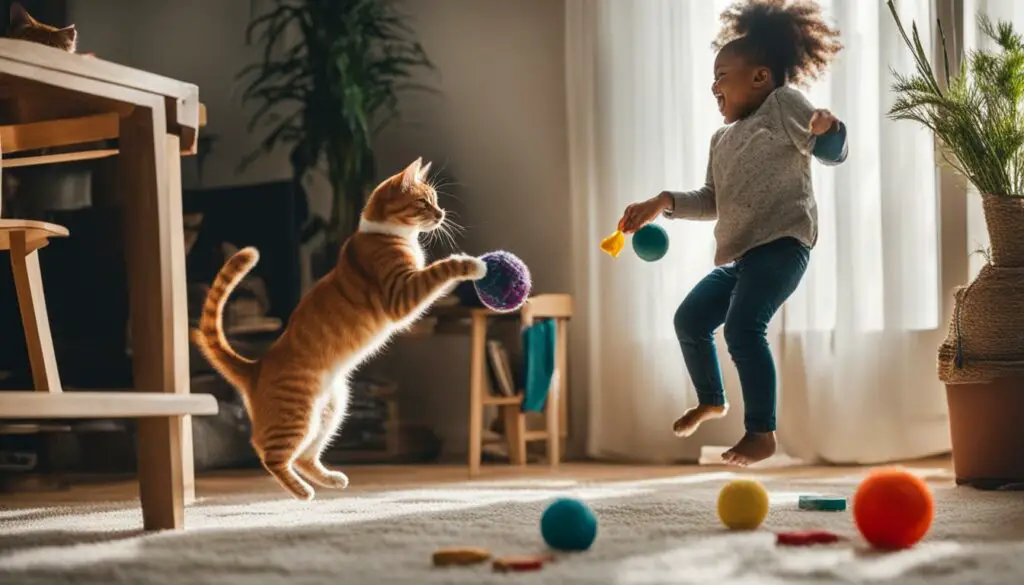
In conclusion, incorporating a play routine into your cat’s daily schedule is crucial for their overall well-being. It provides mental stimulation, physical exercise, and opportunities for socialization. Playtime is an enjoyable way to bond with your cat and keep them happy and healthy. Make play a regular part of their routine and watch them thrive!
The Value of a Consistent Feeding Schedule
Feeding routine plays a crucial role in maintaining the health and well-being of cats. A consistent mealtime routine provides several benefits to cats, including portion control, satiety, and weight management. By establishing set feeding times, you can regulate the amount of food your cat consumes, preventing overeating and maintaining a healthy weight. Consistency in feeding also helps cats feel satiated, reducing their desire for excessive snacking and promoting balanced nutrition.
A consistent feeding schedule is particularly important for cats that tend to eat too quickly or have a tendency to overeat. By dividing their daily food intake into multiple smaller meals throughout the day, you can encourage slower eating and prevent digestive discomfort. This also allows for better portion control, ensuring that your cat receives the appropriate amount of food for their size and activity level.
Proper weight management is essential for cats’ overall health and longevity. Obesity can lead to various health issues, such as diabetes, joint problems, and cardiovascular disease. Establishing a consistent feeding routine helps prevent weight gain and promotes a healthy body condition for your cat. Regular monitoring of their weight and adjustment of portion sizes, if necessary, can help maintain their optimal weight.
| Benefits of a Consistent Feeding Schedule for Cats |
|---|
| Portion control |
| Satiety |
| Weight management |
| Balanced nutrition |
| Prevention of digestive discomfort |
| Prevention of obesity-related health issues |
A consistent feeding routine provides structure and predictability for both you and your cat. It establishes a healthy habit and allows you to bond with your feline companion during mealtime. By creating a calm and positive environment around feeding, you can create a stress-free experience for your cat and enhance their overall well-being. Remember to consult your veterinarian for specific feeding recommendations based on your cat’s age, breed, and health condition.
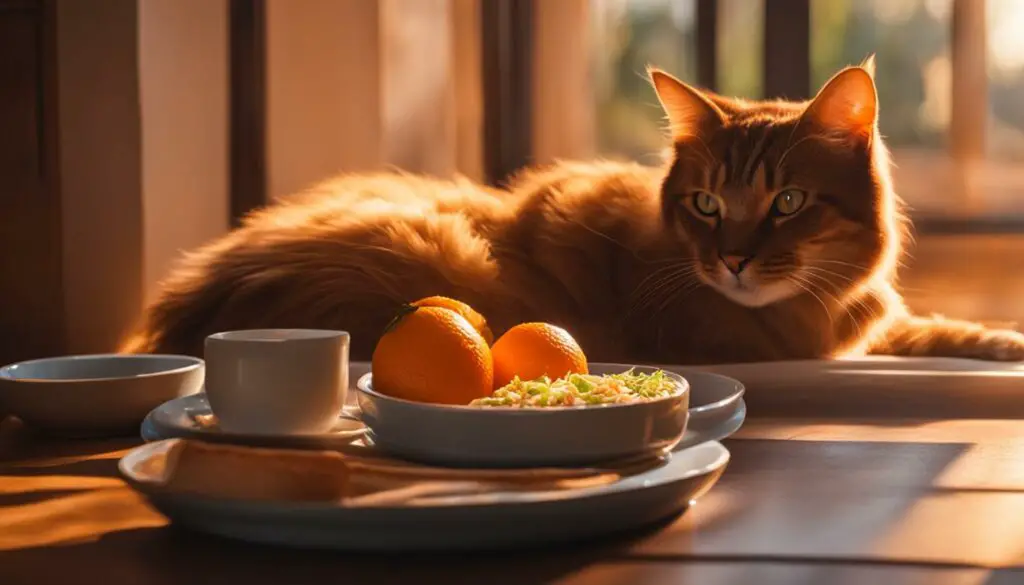
In summary, maintaining a consistent feeding schedule is essential for cats’ health and weight management. A well-regulated mealtime routine promotes portion control, satiety, and balanced nutrition, preventing overeating and maintaining a healthy weight. By establishing a predictable feeding schedule, you provide structure and stability for your cat while fostering a positive bond between you and your feline companion.
Maintaining a Regular Grooming Routine
Grooming is an essential part of keeping your cat healthy and happy. Regular grooming helps maintain their hygiene, promotes a healthy coat, and prevents discomfort. By incorporating a consistent grooming routine, you can ensure that your cat looks and feels their best.
Brushing is a crucial aspect of a cat’s grooming routine. It helps remove loose hair, prevents matting, and stimulates the skin’s natural oils for a shiny coat. Depending on your cat’s breed and coat length, you may need to brush them daily or a few times a week. Regular brushing also provides an opportunity to bond with your cat and monitor their skin health.
Nail trimming is another important grooming task. Cats’ nails can become sharp and pose a risk of scratching and injury. By trimming your cat’s nails regularly, you can prevent them from becoming too long and causing discomfort. It’s best to start nail trimming when your cat is young to accustom them to the process, making it easier for both of you.
| Grooming Task | Frequency |
|---|---|
| Brushing | Varies based on breed and coat length |
| Nail trimming | Every 2-4 weeks |
| Ear cleaning | As needed (check for dirt or wax buildup) |
| Teeth brushing | 2-3 times a week |
Aside from brushing and nail trimming, there are other grooming tasks that you may need to incorporate into your cat’s routine based on their specific needs. These tasks can include cleaning their ears, brushing their teeth, and checking their eyes for any signs of irritation or discharge. Regular grooming not only keeps your cat looking their best but also allows you to monitor their overall health and detect any potential issues early on.
“Regular grooming is essential for maintaining your cat’s hygiene and overall well-being. By incorporating a consistent grooming routine, you can ensure that your cat stays clean, comfortable, and healthy. Remember to make grooming a positive experience for your cat by offering treats, praise, and gentle handling. If you’re unsure about specific grooming techniques or have concerns about your cat’s grooming needs, consult your veterinarian for guidance.”
The Impact of Routine on Litter Box Use
Establishing a consistent routine for your cat’s litter box use is essential for maintaining proper bathroom habits and ensuring their overall well-being. Cats are naturally clean animals and prefer a tidy and fresh litter box. By following a litter box routine, you can promote good litter box habits and prevent issues with inappropriate elimination. Here are some key aspects to consider when it comes to your cat’s litter box routine:
Litter Box Cleanliness
Keeping the litter box clean is crucial for your cat’s satisfaction and hygiene. Cats are more likely to use the litter box consistently when it is clean and free of odor. Scoop the litter box at least once a day to remove solid waste, and replace the litter regularly to maintain cleanliness. By providing a clean litter box, you create an inviting and comfortable space for your cat’s bathroom needs.
Consistent Location
Choose a specific location for the litter box and keep it consistent. Cats rely on routine and familiarity, so having a designated spot for the litter box helps them recognize and find it easily. Avoid moving the litter box unless absolutely necessary, as this can confuse your cat and lead to accidents. Consistency in the location of the litter box contributes to your cat’s sense of security and comfort.
Multiple Litter Boxes
If you have multiple cats or a larger living space, consider providing multiple litter boxes. This ensures that each cat has easy access to a litter box and reduces the likelihood of territorial issues. Place the litter boxes in different areas of your home to accommodate all cats’ preferences and promote harmony among them.
| Advantages | Disadvantages | |
|---|---|---|
| Single Litter Box | – Easier to maintain – Requires less space |
– Potential for territorial disputes – Increased odor and mess |
| Multiple Litter Boxes | – Reduced chance of accidents – Minimize territorial conflicts |
– Requires more cleaning and maintenance – Takes up additional space |
By incorporating these aspects into your cat’s litter box routine, you can ensure that they have a clean and comfortable space for their bathroom needs. Remember to monitor your cat’s litter box habits and make adjustments to the routine as needed. A consistent and well-maintained litter box routine will contribute to your cat’s overall happiness and well-being.
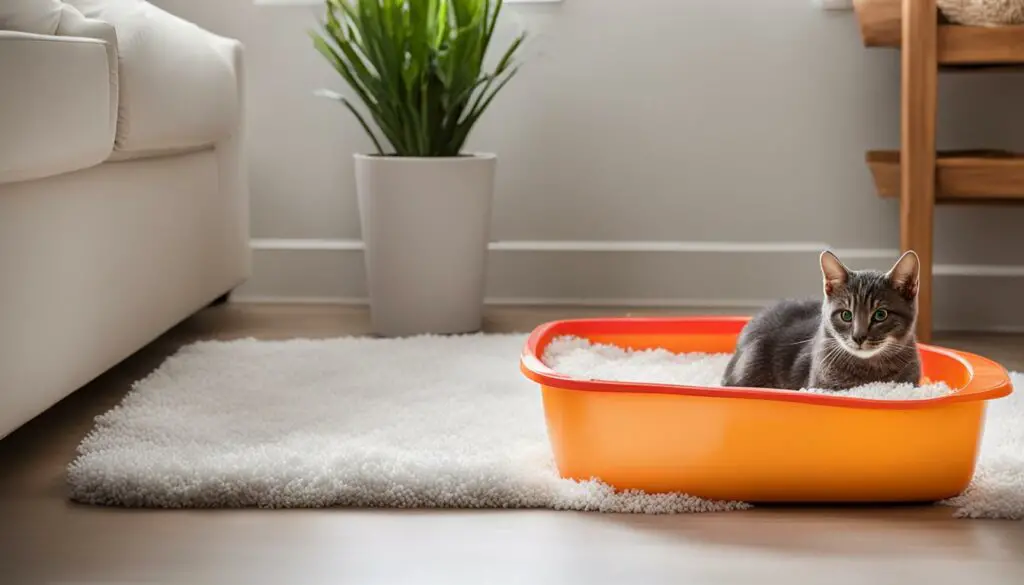
The Role of Routine in Training and Socialization
When it comes to training and socializing cats, routine is key to success. Establishing a training routine allows for consistency and repetition, which are essential for cats to learn and retain desired behaviors. Whether you’re teaching them to use a scratching post or to come when called, sticking to a routine helps reinforce these behaviors over time. Cats thrive on positive reinforcement, so incorporating treats and praise into your training routine will further motivate them to learn and comply.
In addition to training, socialization is vital for cats to develop healthy relationships with humans and other animals. Creating a socialization routine that includes regular positive interactions is crucial. This can involve playtime, cuddling, or simply spending quality time together. By consistently engaging in these positive interactions, you help cats associate humans and other animals with happiness and comfort, making them more confident and sociable.
It’s important to note that each cat is unique, and their training and socialization needs may vary. Some cats may require more time and patience to learn new behaviors or adjust to new environments. By establishing a routine tailored to your cat’s individual needs and consistently providing positive interactions and reinforcement, you can create an environment that fosters their learning and social development.
Training and Socialization Routine Checklist
- Set aside dedicated time each day for training sessions.
- Use positive reinforcement, such as treats and praise, to reward desired behaviors during training.
- Create a socialization routine that includes regular positive interactions with humans and other animals.
- Engage in playtime, cuddling, or other bonding activities on a consistent basis.
- Be patient and understanding, as each cat learns at their own pace.
Frequently Asked Questions
“Can I train an older cat or one with behavioral issues?”
Yes, training is possible for cats of all ages and backgrounds. However, it may require more time and patience, especially for cats with behavioral issues. Consulting with a professional animal behaviorist can provide guidance tailored to your cat’s specific needs.
“What if my cat doesn’t respond well to training?”
Not all cats are equally responsive to training methods. If your cat doesn’t seem motivated or is resistant to training, it’s important to reassess your approach and consider alternative techniques. Seek advice from a professional if needed.
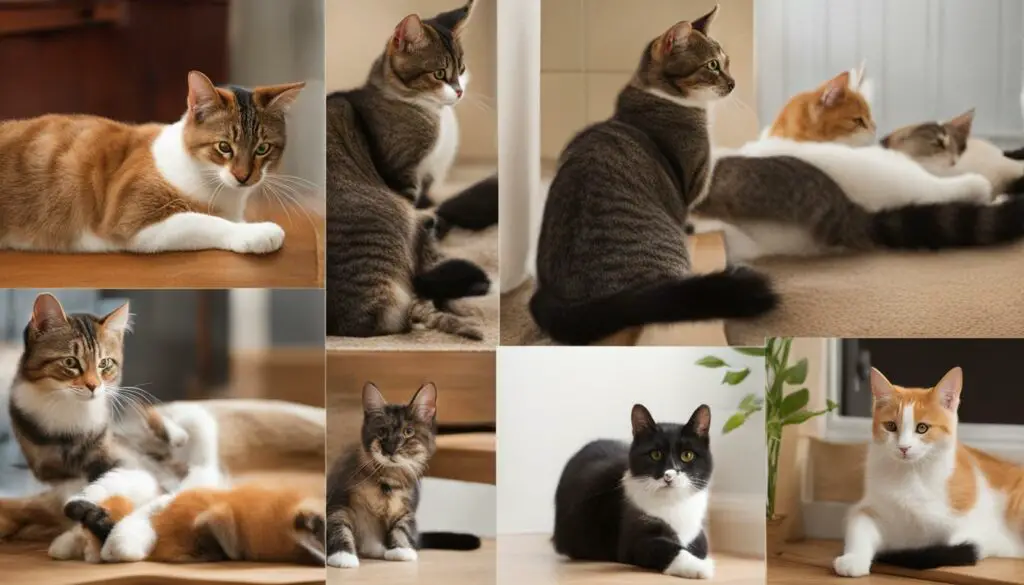
Conclusion
From their daily habits and behaviors to their need for predictability and consistency, it is evident that cats love routine. Having a structured routine is essential for their well-being and overall happiness. Routine provides cats with comfort, stability, and a sense of security, allowing them to feel safe and confident in their environment.
By incorporating routine into their daily lives, we can ensure that cats have a consistent schedule that meets their needs. From feeding and grooming routines to playtime and socialization, routine plays a vital role in every aspect of their lives. It helps them adapt to changes more easily and reduces stress and anxiety.
Cats thrive in an environment that offers familiarity and stability. Establishing and maintaining a routine that includes predictable activities and interactions promotes their physical and mental health. It allows them to engage in natural behaviors, explore their surroundings, and feel independent and secure.
So, if you want to keep your feline friend happy and content, embrace the power of routine. Create a structured environment that provides cats with comfort, consistency, and the freedom to be themselves. By doing so, you’ll be rewarded with a happy, healthy, and well-adjusted cat by your side.
FAQ
Do cats really like routine?
Yes, cats are creatures of habit who thrive on routine. Routine provides them with structure, predictability, and a sense of security.
Why is routine important for cats’ well-being?
Routine is important because it helps cats feel safe, confident, and in control of their environment. It reduces stress and anxiety, promotes good behavior, and contributes to their overall mental and physical health.
How does routine affect cats’ territory marking behavior?
Routine helps cats establish and maintain their territory by allowing them to become familiar with their environment and mark it with their scent. This signals to other cats that the territory is already claimed.
Does routine make cats feel more independent and secure?
Yes, routine contributes to cats’ sense of independence, autonomy, and self-sufficiency. By having a predictable routine, cats feel more confident, secure, and in control of their surroundings.
Can routine help minimize stress and anxiety in cats?
Absolutely! Routine provides cats with a sense of relaxation, comfort, and predictability. By knowing what to expect, cats experience less stress and anxiety in their daily lives.
How does routine affect cats’ daily care activities?
Routine is crucial for cats’ daily care activities. It helps regulate feeding schedules, sleep patterns, grooming routines, and litter box use. Consistency in these activities promotes their well-being and comfort.
Does routine play a role in shaping cats’ behavioral patterns?
Yes, routine helps reinforce desired behaviors and makes training more effective. It also enhances socialization with humans and other animals, promoting positive interactions and preventing unwanted behavioral changes.
How does a structured environment benefit cats?
A structured environment provides cats with familiarity, stability, and a sense of security. It allows them to adapt more easily to changes and variations in their surroundings.
Why do cats prefer familiar surroundings?
Cats feel more at ease and comfortable in familiar surroundings. Routine creates a sense of sameness and balance for cats, making them feel secure in their home environment.
What role does routine play in cats’ sleep patterns?
Routine is essential for cats’ restorative sleep. By maintaining a consistent sleep routine, cats can get the uninterrupted sleep they need for physical and mental rejuvenation.
How does routine impact cats’ playtime and exercise needs?
Routine provides cats with mental stimulation and physical exercise. Regular play sessions allow them to engage in their natural hunting instincts and prevent boredom.
Why is a consistent feeding schedule important for cats?
A consistent feeding schedule helps regulate portion control, prevents overeating, and promotes overall health and weight management in cats.
What role does routine play in grooming?
Routine is essential for maintaining a regular grooming routine, including brushing and nail trimming. It helps keep cats comfortable, promotes hygiene, and maintains their overall health.
How does routine affect litter box use in cats?
By following a consistent litter box routine, cats are more likely to use the litter box consistently. Routine cleaning and maintenance of the litter box ensure it remains a clean and comfortable space for their bathroom needs.
Does routine play a role in training and socialization?
Yes, routine promotes consistency and repetition in training, making it easier for cats to learn and retain desired behaviors. It also helps with their socialization by creating a structured approach that includes regular positive interactions.
Please note that this is a sample list of frequently asked questions based on the provided information. The actual questions and answers may vary depending on the specific content and context.





